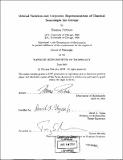Orbital varieties and unipotent representations of classical semisimple Lie group
Author(s)
Pietraho, Thomas, 1973-
DownloadFull printable version (6.369Mb)
Other Contributors
Massachusetts Institute of Technology. Dept. of Mathematics.
Advisor
David A. Vogan.
Terms of use
Metadata
Show full item recordAbstract
Let G be a complex semi-simple and classical Lie group. The notion of a Lagrangian covering can be used to extend the method of polarizing a nilpotent coadjoint orbit to obtain a unitary representation of G. W. Graham and D. Vogan propose such a construction, relying on the notions of orbital varieties and admissible orbit data. The first part of the thesis seeks to understand the set of orbital varieties contained in a given nipotent orbit. Starting from N. Spaltenstein's parameterization of the irreducible components of the variety of flags fixed by a unipotent, we produce a parameterization of the orbital varieties lying in the corresponding fiber of the Steinberg map. The parameter set is the family of standard Young or domino tableau of a given shape. The key to the proof is understanding certain closed cycles as defined by D. Garfinkle. This parameterization is particularly useful; it provides a method of determining the r-invariant of each orbital variety, as well as a way of relating an orbital variety in any classical group to one lying in type A. (cont.) The second part of the thesis addresses the representations V(V, ir) constructed by Graham and Vogan. A natural question is how well the V(V, 7r) approximate the set of unipotent representations that ought to be attached to the nilpotent orbit 0. The answer is promising in the setting of spherical orbits. When it is possible to carry out the Graham-Vogan construction, the corresponding infinitesimal character lies in the set of characters suggested by W. M. McGovern. Furthermore, we show that it is possible to carry out the Graham-Vogan construction for a suffient number of orbital varieties to account for all the infinitesimal characters attached to 0 by McGovern.
Description
Thesis (Ph. D.)--Massachusetts Institute of Technology, Dept. of Mathematics, 2001. Includes bibliographical references (p. 81-83).
Date issued
2001Department
Massachusetts Institute of Technology. Department of MathematicsPublisher
Massachusetts Institute of Technology
Keywords
Mathematics.